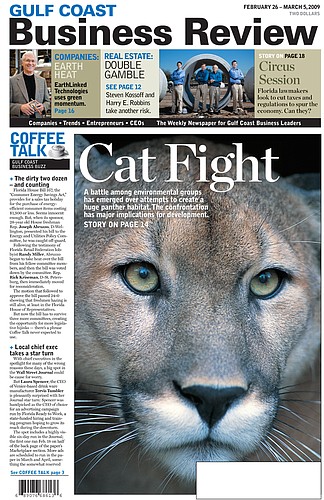- November 26, 2024
-
-
Loading

Loading

About 100 panthers in South Florida may hold the key to whether large-scale development will be allowed on more than 1.1 million acres in Collier, Lee and Hendry counties.
That's because environmental groups led by the Naples-based Conservancy of Southwest Florida have petitioned the federal government to designate the land as panther habitat. These nearly extinct animals need millions of acres to roam.
“The issue is how much urban sprawl is going to happen in the far interior of Collier County,” says Andrew McElwaine, president of the Conservancy. “The panther is the issue around which it revolves.”
If the panther habitat is designated as the species critical habitat, many other species will be protected in those areas too. “It's like the tent-pole species,” McElwaine says.
The land in question is double the size of Lee County and its impact would be felt most in Collier County, where it would hamper any future development and job creation east of Naples. Landowners say the panther designation on such a broad swath of land would stunt growth in a county that already suffers from an anti-business reputation. It also could drive up land prices in one of the most expensive counties to live in.
The Conservancy receives funds from wealthy Naples residents as well as current and retired executives, including the group's chairman, Dolph Von Arx. Von Arx has been active in economic development circles in Collier County, including as chairman of the Regional Business Alliance.
Landowners in these areas have proposed their own panther-protection plan and a team of scientists recently made recommendations to it that included widening panther corridors.
This group of scientists also included a representative from the Conservancy.
“I loved the recommendations and I think they need to be adopted in block,” McElwaine says.
Still, McElwaine says the Conservancy doesn't plan to withdraw its petition with the federal government. That's because adoption of the scientists' recommendations could form the basis for a federally designated habitat plan for the panthers, he says.
The Sierra Club recently joined the Conservancy by filing its own petition to set aside land for the panther. Other environmental groups that have also joined the effort include The Center for Biological Diversity, the Public Employees for Environmental Responsibility and Council for Civic Associations.
Until now, the federal government hasn't acted on any of the petitions because a negotiated settlement is preferable.
“We're not at the point where we would litigate our petition,” McElwaine says. “Those big policy decisions will go before the board at the end of the year and
they'll make a decision on what to do.”
— Jean Gruss